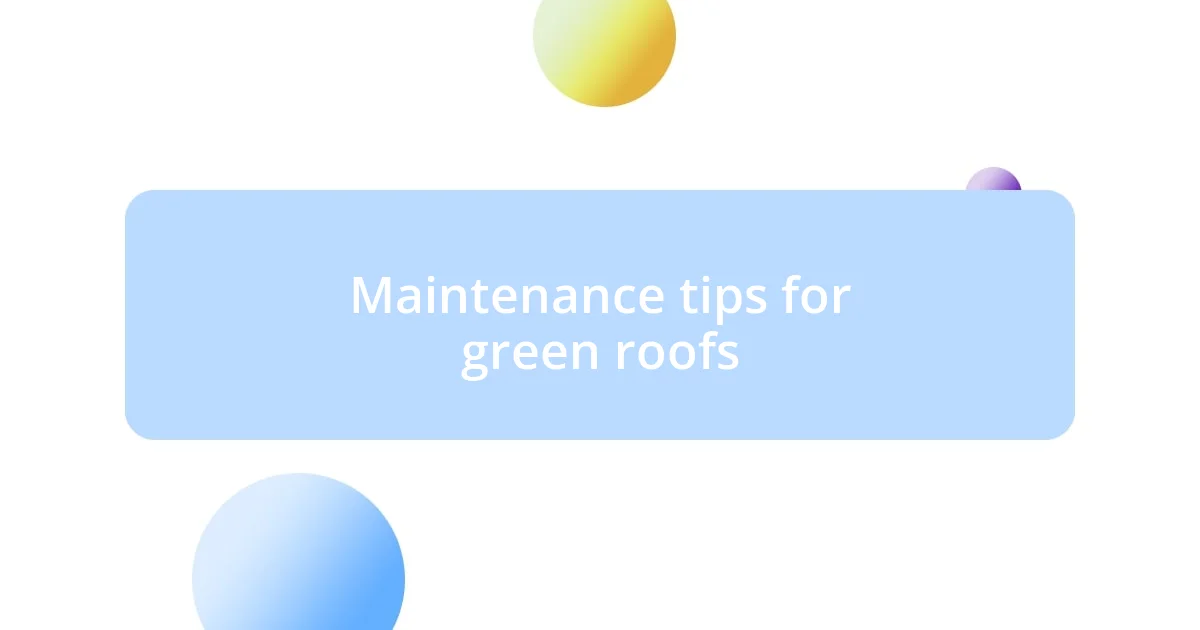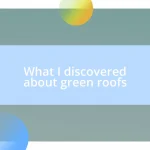Key takeaways:
- Green roofs enhance urban biodiversity, reduce heat, and improve energy efficiency, leading to significant cost savings in heating and cooling.
- Two main types of green roofs—extensive (low maintenance, shallow soil) and intensive (high maintenance, deeper soil)—cater to different needs and lifestyles.
- Although the initial installation cost of green roofs can be high, long-term savings and potential financial incentives make them economically viable and environmentally beneficial.

Understanding green roofs benefits
The benefits of green roofs are profound and multi-faceted. Personally, I was blown away when I learned that these living roofs can reduce urban heat, making cities a bit cooler in the summer. Isn’t it fascinating to think that a simple plant can help combat the heat islands we often dread during hot weather?
I remember visiting a building with a green roof and witnessing the wildlife it attracted—birds chirping, butterflies fluttering around. It struck me then that green roofs aren’t just about aesthetics; they promote biodiversity. Have you ever stopped to consider how many species benefit from what we sometimes overlook as mere decoration?
Moreover, green roofs can significantly improve energy efficiency. I’ve seen reports showing they can lower heating and cooling costs by as much as 25%. Just imagine how that translates into financial savings for homeowners and businesses alike over time. Doesn’t it make you wonder why we don’t prioritize these green solutions more often?

Types of green roofs available
There are primarily two types of green roofs: extensive and intensive. Extensive green roofs are light and support a shallow layer of soil, making them easier to install and maintain. I recall the first time I walked on an extensive green roof; it felt refreshing underfoot, like stepping into a mini-ecosystem right in the heart of the city. Intensive green roofs, on the other hand, require deeper soil and can accommodate larger plants, essentially creating a rooftop garden paradise. Just imagining tending to a vegetable patch on my roof brings me joy; it’s a small yet significant way to connect with nature.
In my experience, I find that extensive roofs work best for commercial buildings where the load is a concern. They usually involve lower costs and less maintenance, and I appreciate how they contribute beautifully to building aesthetics. However, for residential spaces, intensive roofs often attract those with a passion for gardening and design. I remember visiting a friend’s home with a stunning intensive green roof; it felt like an oasis, bursting with colorful flowers and leafy greens.
When choosing between these types, it’s essential to consider factors like budget, maintenance, and desired greenery. Personally, I believe extensive roofs are perfect for anyone looking for a low-maintenance option, while intensive roofs cater to those who want a lush and vibrant outdoor area. In many ways, your choice might reflect your lifestyle—are you looking for simplicity or the joy of gardening?
| Type | Description |
|---|---|
| Extensive | Shallow soil, low maintenance, light weight, suited for flat rooftops. |
| Intensive | Deeper soil, high maintenance, supports larger plants and gardens. |

Maintenance tips for green roofs
Maintaining a green roof is crucial for ensuring its long-term health and functionality. I’ve learned that routine inspections can really pay off. Regular checks allow you to spot issues like weeds, pests, or drainage problems before they escalate. During one of my own maintenance days, I discovered a small patch of unwanted weeds that, if left unchecked, could have spread throughout the entire area. It was a reminder of how vigilance often leads to easier maintenance in the long run.
Here are some practical tips for maintaining green roofs:
- Inspect regularly: Check for drainage issues, weeds, and plant health at least twice a year.
- Water appropriately: Ensure proper irrigation, especially during dry spells, to prevent stress on the plants.
- Fertilize wisely: Use organic fertilizers sparingly to boost plant health without overloading the system.
- Trim and prune: Regularly trimming plants helps encourage growth and maintain the desired aesthetic.
- Watch for pests: Keep an eye out for insects, and use organic pest control methods if needed.
I also find that educating myself about the specific plants I’m growing makes a significant difference. Understanding their needs helps me tailor my care strategies to create a thriving environment. The joy I feel when seeing my plants flourish is genuinely rewarding—it’s almost like nurturing a little ecosystem that’s uniquely mine.

Environmental impact of green roofs
The environmental impact of green roofs is profound and multifaceted. I remember a conversation I had with a local environmentalist who passionately explained how green roofs can significantly reduce urban heat. They absorb sunlight and regulate temperatures, which helps mitigate the heat island effect in cities. Isn’t it fascinating to think that by simply growing plants on our roofs, we can cool down entire neighborhoods?
Moreover, the benefits extend beyond temperature control. I’ve observed that these green spaces contribute to improved air quality. As plants naturally filter pollutants and carbon dioxide, I often find myself breathing fresher air in areas adorned with lush, vibrant greenery. It’s remarkable how a tiny habitat atop a building can transform the urban landscape and enhance the quality of life for its inhabitants.
Additionally, green roofs play a crucial role in stormwater management. During a particularly heavy rainstorm, I was amazed to see how a well-designed green roof absorbed a significant amount of rainfall. This not only prevents flooding but also reduces the pressure on municipal drainage systems. It really makes you wonder—how many cities could benefit from implementing more green roofs? In my view, each new green roof is a step toward a more sustainable future.

Cost considerations for green roofs
Cost is a critical factor when considering the installation of a green roof. From my experience, while the initial investment can be steep, often ranging from $10 to $25 per square foot, many underestimate the long-term savings. For instance, in a project I was involved with, the green roof not only lowered energy bills due to improved insulation but also increased property value—making the initial cost seem like a smart investment over time.
It’s also essential to account for ongoing maintenance expenses. Based on my observations, these costs can vary significantly depending on the roof design and plant selection. During one maintenance session, I realized that opting for local native plants led to reduced watering and fertilizing needs, mostly due to their resilience to our local climate. This choice ultimately saved us money, proving that thoughtful plant selection can significantly impact budget considerations in the long run.
Have you thought about the potential for financial incentives? Many municipalities offer tax breaks or grants for green roofs, which can help offset initial costs. In my city, I was pleasantly surprised to discover a program that provided funding for green infrastructure. This initiative made the green roof project not only environmentally beneficial but also economically sensible—an opportunity I think many should explore!












